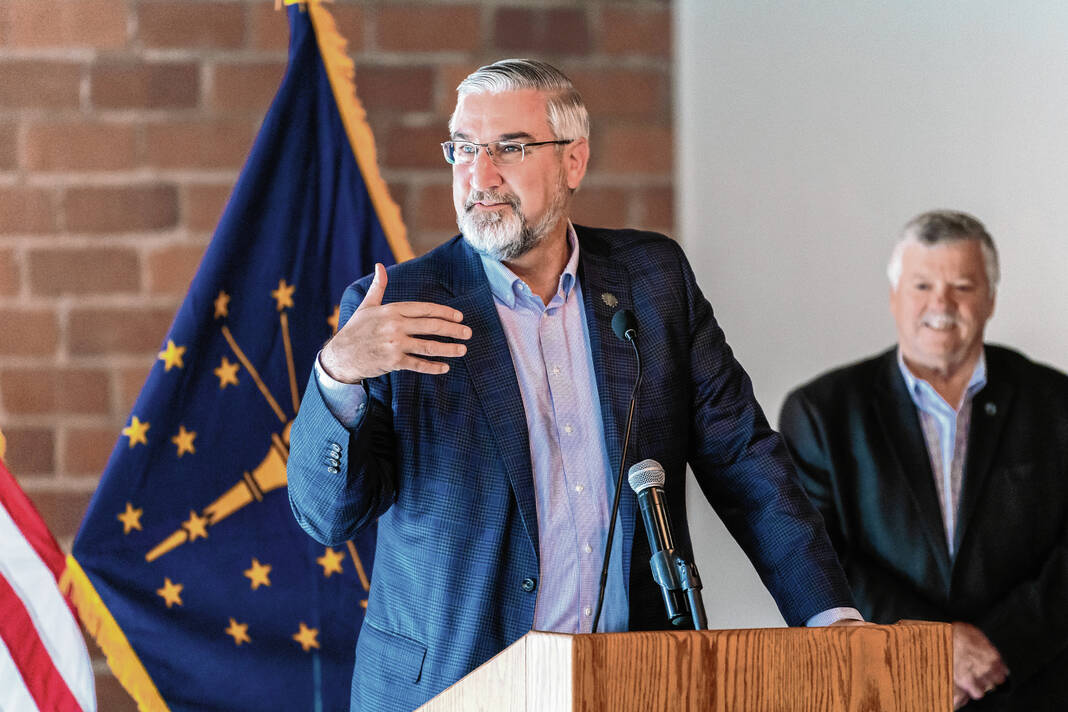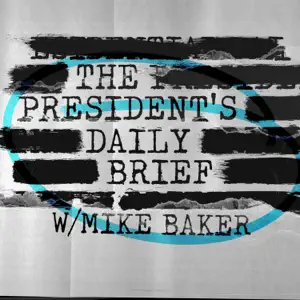
Time to end secret data laboratories—starting with the CDC
The American people are waking up to the fact that too many public health leaders have not always been straight with them. Despite housing treasure…
Thought Leader: Marty Makary

As his time in office ends, Indiana Gov. Eric Holcomb is proud of what he’s been able to accomplish and set in motion for the state.
Holcomb, 56, leaves office as Indiana’s 51st governor on Jan. 13, when successor U.S. Sen. Mike Braun will take the reins. Throughout Holcomb’s nearly eight years in office, he has overseen the completion of many projects, including Interstate 69, and more than $126 billion in capital investments for the state. His time as governor also included managing the state’s response to the coronavirus pandemic in 2020 and the housing of Afghan refugees at Camp Atterbury in 2021 and 2022.
Holcomb reflected on his time in office in an interview with the Daily Journal at his office inside the Indiana Statehouse on Wednesday — the 208th anniversary of Indiana’s statehood. He also looked ahead to what’s next for him.
Going into his final days in office, Holcomb and his staff are keeping track of what all still needs to get done, he said. He’s also keeping track of exactly how much time he has left, specifically about 32 days and more than 700 hours, he said.
“It’s like a funnel where you start out with four years, and then you get down to four months, and then you’re getting closer to four weeks, and then it’ll be four days, and then it’ll be a day,” Holcomb said. “You don’t get to say, ‘Well, we’ll just do that next year.’ We don’t get to say that.”
There’s still a lot to do “every single day” which keeps him and his staff busy from morning to evening, he said. For example, Holcomb had a series of events on Wednesday, including a celebration marking the 208th anniversary of Indiana’s statehood.
“You’re still driven on adrenaline and [a] lot of team energy,” he said.
Holcomb says he and his staff have to be mindful of what needs to be done and not just what they’d like to see done. This will leave them as “busy on our last day as it will my successor’s first day,” he said.
“We’re going to leave the cupboard full and … a pipeline full of projects that had I had another year in office I’d be working on,” Holcomb said. “So we’ll be able to hand that over and say, ‘To be continued,’ according to my successor’s priorities, and feel good about the last eight years and all we’ve contributed.”
As governor, Holcomb has gone on more than 20 international trips to build economic relationships with other countries. These trips included visits to Singapore, Ukraine, Switzerland and Saudi Arabia.
Holcomb says these efforts were built on the “very strong foundation” of his predecessors. He has sought to go to these places because of the global market and the increasing interconnectedness of the world, not just with national security interests but also economic ones, he said.
Indiana is known as the No. 1 state in the U.S. for its manufacturing per capita, which is reliant on good supply lines and a healthy supply chain, he said. For America’s market and consumer base, the state wants its companies to grow internationally and at home, Holcomb said.
Officials also want companies worldwide to come to Indiana not only for the “health and wealth” of Hoosiers but to grow Indiana’s share of investments. Three years ago, the Indiana Economic Development Corp. set an all-time record of new committed capital investment for the state at $8.7 billion. That record has already been broken every year since then, and Indiana is already at $39 billion for this year, Holcomb said.
“This $8.7 [billion] was the all time record for 205 years, and yet we’re now at $30 million north of that. And that puts in perspective how important growing here is,” he said.
He cited the state’s numerous small, medium and large businesses who are staying in the state as examples of these efforts. These companies include Cummins, Eli Lily, Zimmer Biomet, Cook Medical and Allison Transmission, he said.
Last year, the state saw $28.7 billion in new investment — 70% of which was from direct foreign investment. The state doesn’t like to leave $20 billion “on the table” that could benefit Indiana’s ecosystem, Holcomb said.
“We’re not just farming our ecosystem — we’re hunting. We’re going out and we’re bringing back,” Holcomb said.
He added that Indiana has a small footprint compared to other states, like Texas, but officials here are “punching way above our weight class” because they’re able to earn the trust of investors and companies that want to grow. But what’s key is showing up, Holcomb said, using a phrase he’s evoked before when discussing why he’s taken the international trips.
“The travel is not to go sightseeing or [wear] shorts and sunscreen. It’s showing up, [it’s] the bare minimum,” Holcomb said. “And the good that comes from that is master 20 plus billion in new investment that would have gone somewhere, and it fortunately didn’t go to one of our competitors. It came to Indiana.”
Dozens of projects and initiatives were completed under Holcomb’s term, including finishing the expansion of I-69, awarding $1.7 billion in Community Crossings road work grants, establishing Indiana’s first Office of Drug Prevention, Treatment & Enforcement to combat the opioid crisis, appointing the state’s first secretary of education and providing READI grants to regions throughout the state to invest in their communities.
Holcomb highlighted several other projects on Wednesday. The double-track project for the South Shore line in northwestern Indiana is one of those, which made a train line a double-track for the first time in a century, he said.
Holcomb says he sees his accomplishments through different lenses, including unlocking and attracting “billions of investment” along that commuter rail line.
Promoting “good policy” that has helped the state grow is one of those lenses. Out of that growth, came the ability to embark and pay for several projects with cash on hand, instead of bonding or borrowing money, Holcomb said.
These projects include a new $1.2 billion correctional facility in LaPorte County that merges two facilities into one, a new Indiana State Police Post and Laboratory in Evansville, new armories, a new lodge at Potato Creek State Park in St. Joseph County — the first built since 1939, a new pavilion at the Indiana State Fairgrounds, new welcome centers around the state and a new state archives building in downtown Indianapolis.
“All these projects … were talked about, were wanted for decades — not years, not sessions [but] decades — and to realize them, to celebrate their openings or their groundbreakings, that shows that we hit another milestone that we’ve allocated the dollars to them, that we didn’t have to say, ‘Well, we would if we could.’ We are now saying, ‘We will and we are.’ And that is something really to be proud of,” Holcomb said.
Holcomb also highlighted increasing funding for local health departments across all 92 counties, having funding available to increase K-12 resources by “well over” a billion dollars and being able to cut taxes to pay down debt — including paying off 35% of the state’s debt. The state was already a “low state debt” state to begin with and was still able to pay off 35%, he said.
“You don’t get to send tax rebates or refunds if you don’t have the cash,” he said.
Indiana has also added $154 billion to the state’s gross domestic product, which is still increasing, Holcomb said. The state used to be below the national average for productivity but is now above it too, he said.
“Those numbers reflect the ability to fund your priorities, and that’s what I’m proud of,” Holcomb said. “We’ve minded the fiscal store, grown our economy and made unprecedented investments in people and places like never before.”
Holcomb says his wife Janet has said the last eight years have been about his schedule, but the next two or so months will be about their schedule and hers, he said. He also says he’s grateful for her support because he couldn’t have done the job without her.
“We’ll be able to exhale and not wake up every day with that adrenaline of knowing and not knowing what the day would bring,” Holcomb said.
Holcomb says he will take a couple of months to decide what to do next. He doesn’t want to rush into any decision. There have been some “very exciting and interesting” opportunities that have come his way, but he’s asked those responsible for them if they could wait a few months to have conversations, he said.
He does want to stay in Indiana. As for potential lines of work, he’s most interested in working with companies or organizations that are focused on growing in “innovative, technologically-driven ways,” which is where he says he’s spent a lot of time over his term.
When Hoosiers reflect on Holcomb’s time in office about five to 10 years from now, he hopes that they think of it as a time when there was a person in office who was calm, fair, kind and respectful, he said.
“Those things that you learn from your parents, or maybe even a third-grade teacher, are true in the rest of life as well,” Holcomb said.
He also hopes Hoosiers remember it as a time of “explosive economic growth” where state officials were able to steer the state into “prosperous places.” This is also with the backdrop of a world “in flux or [in] some chaos, some at odds with one another, the division,” he said.
“We were able to prove that there was a better way and that we’ll go further and faster when we go together,” Holcomb said. “And that’s what I’ve sought to do, is bring people together.”
In the end, Holcomb says it could be “unnerving” to some to know that they are going to be in a different home or job in a few months. But he’s optimistic for the future, he said.
“It’s been an exciting and good run the last eight years. And I’m optimistic about the future as well,” Holcomb said.
Governor Eric Holcomb’s nearly eight years of leadership in Indiana have been defined by transformative economic growth, innovative infrastructure projects, and a steady, forward-thinking approach to governance. His successful global outreach for foreign investments and his focus on fiscal responsibility have helped secure a prosperous future for Indiana. As a keynote speaker, Holcomb’s insights into effective leadership, strategic decision-making, and creating long-term positive impact are invaluable for any audience looking to drive change and economic success in their own organizations or regions. To host Gov. Holcomb at your event, contact WWSG.
Time to end secret data laboratories—starting with the CDC
The American people are waking up to the fact that too many public health leaders have not always been straight with them. Despite housing treasure…
Thought Leader: Marty Makary
David Frum: How Harris Roped a Dope
This piece is by WWSG exclusive thought leader, David Frum. Vice President Kamala Harris walked onto the ABC News debate stage with a mission: trigger…
Thought Leader: David Frum
Michael Baker: Ukraine’s Faltering Front, Polish Sabotage Foiled, & Trump vs. Kamala
In this episode of The President’s Daily Brief with Mike Baker: We examine Russia’s ongoing push in eastern Ukraine. While Ukrainian forces continue their offensive…
Thought Leader: Mike Baker

